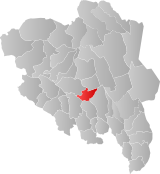
Back Lillehammer Afrikaans ليلهامر Arabic Lillehammer Azerbaijani Лиллехаммер Bashkir Lėlehameris BAT-SMG Лілехамер Byelorussian Лілегамэр BE-X-OLD Лилехамер Bulgarian Lillehammer BJN লিল্লেহামের BPY
Lillehammer Municipality
Lillehammer kommune | |
|---|---|
 View of the town of Lillehammer | |
 Innlandet within Norway | |
 Lillehammer within Innlandet | |
| Coordinates: 61°7′N 10°28′E / 61.117°N 10.467°E | |
| Country | Norway |
| County | Innlandet |
| District | Gudbrandsdal |
| Established | 1 Jan 1838 |
| • Created as | Formannskapsdistrikt |
| Administrative centre | Lillehammer |
| Government | |
| • Mayor (2023) | Hans Olav Sundfør (H) |
| Area | |
• Total | 477.95 km2 (184.54 sq mi) |
| • Land | 450.72 km2 (174.02 sq mi) |
| • Water | 27.23 km2 (10.51 sq mi) 5.7% |
| • Rank | #211 in Norway |
| Population (2023) | |
• Total | 28,560 |
| • Rank | #39 in Norway |
| • Density | 63.4/km2 (164/sq mi) |
| • Change (10 years) | |
| Demonym | Lillehamring[1] |
| Official language | |
| • Norwegian form | Bokmål |
| Time zone | UTC+01:00 (CET) |
| • Summer (DST) | UTC+02:00 (CEST) |
| ISO 3166 code | NO-3405[3] |
| Website | Official website |
Lillehammer (Norwegian pronunciation: [ˈlɪ̂lːəˌhɑmːər] ) is a municipality in Innlandet county, Norway. It is located in the traditional district of Gudbrandsdal. The administrative centre of the municipality is the town of Lillehammer. Some of the more notable villages in the municipality include Fåberg, Hunderfossen, Jørstadmoen, Vingnes, and Vingrom.
The 478-square-kilometre (185 sq mi) municipality is the 211th largest by area out of the 356 municipalities in Norway. Lillehammer is the 39th most populous municipality in Norway with a population of 28,560. The municipality's population density is 63.4 inhabitants per square kilometre (164/sq mi) and its population has increased by 6.4% over the previous 10-year period.[4][5]
The town of Lillehammer is the largest urban centre in the municipality. It lies in the central part of the municipality and it is surrounded by more rural areas. The town centre is a late nineteenth-century concentration of wooden houses, which enjoys a picturesque location overlooking the northern part of lake Mjøsa and the river Lågen, surrounded by mountains. Lillehammer hosted the 1994 Winter Olympics and 2016 Winter Youth Olympics.[6]
- ^ "Navn på steder og personer: Innbyggjarnamn" (in Norwegian). Språkrådet.
- ^ "Forskrift om målvedtak i kommunar og fylkeskommunar" (in Norwegian). Lovdata.no.
- ^ Bolstad, Erik; Thorsnæs, Geir, eds. (26 January 2023). "Kommunenummer". Store norske leksikon (in Norwegian). Kunnskapsforlaget.
- ^ Statistisk sentralbyrå (2022). "Table: 06913: Population 1 January and population changes during the calendar year (M)" (in Norwegian).
- ^ Statistisk sentralbyrå (2022). "09280: Area of land and fresh water (km²) (M)" (in Norwegian).
- ^ "Lillehammer awarded 2016 Winter Youth Olympic Games". 7 December 2011.
